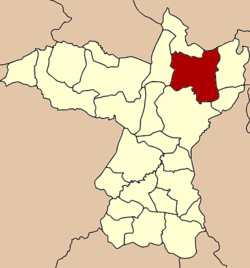Nam Phong District
Nam Phong (Thai: น้ำพอง, pronounced [náːm pʰɔ̄ːŋ]) is a district (amphoe) of Khon Kaen Province.
Nam Phong น้ำพอง | |
|---|---|
 District location in Khon Kaen Province | |
| Coordinates: 16°42′7″N 102°51′24″E | |
| Country | Thailand |
| Province | Khon Kaen |
| Seat | Wang Chai |
| Area | |
| • Total | 828.7 km2 (320.0 sq mi) |
| Population (2008) | |
| • Total | 112,414 |
| • Density | 136.8/km2 (354/sq mi) |
| Time zone | UTC+7 (ICT) |
| Postal code | 40140 |
| Geocode | 4007 |
Geography
Neighboring districts are (from the north clockwise): Non Sa-at of Udon Thani Province; Kranuan, Sam Sung, Mueang Khon Kaen, Ubolratana and Khao Suan Kwang.
The district is on Mittraphap Road (Thailand Route 2) and the northeastern railway. The district office and the train station are about 7 km east of the main settlement, Ban Nam Phong.
Despite its name, Nam Phong National Park does not occupy any of Nam Phong District, but is southeast of the district. Both are named after the Nam Phong River, which originates in the national park, and after the Ubol Ratana Dam flows through the district towards the Chi River.
Economy
The district is mostly agricultural, its main activities being rice and sugar cane growing and animal husbandry. The two major factories are a sugar factory and a distillery for lao kao (white spirits).
An oil survey in 1979 found a natural gas reserve of an estimated 1.5 trillion cubic feet (42 km3). Since 1989 the gas field has been exploited for the Nam Phong power plant operated by EGAT. With a capacity of 710 MW, it is the main source of electricity for northeast Thailand.[1]
History
The district was created on 10 February 1908, at first named Tha Wa (ท่าหว้า). In 1909 it was renamed Nam Phong.[2]
From 1972 to 1973 the Royal Thai Air Base Nam Phong was a US military facility used in the Vietnam War.
Attractions
Phrathat Kham Kaen is an ancient Buddhist monument. The stupa, at Wat Chetiyaphum, is believed to mark the original site of Khon Kaen. According to local legend, relics of Buddha were to be brought to Nakhon Phanom. The monks camped at a dead tamarind tree. When they arrived in Nakhon Phanom the Phrathat Phanom was already finished, thus they planned to return the relics. On the return way they found the dead tree flourishing again, and built the stupa at the site of the miracle.[3]
Ban Khok Sa-nga is famous as the King Cobra Village. In 1951 a local doctor started to conduct cobra shows to attract clients to the village. Now the cobra shows are the main income of the villagers, who also travel around to perform the show and sell herbal medicine.[4]
Administration
The district is divided into 12 sub-districts (tambons), which are further subdivided into 167 villages (mubans). There are two sub-district municipalities (thesaban tambons): Nam Phong covering parts of tambon Nam Phong, and Wang Chai covering parts of tambons Wang Chai and Nong Kung. Each of the tambons is administered by a tambon administrative organization (TAO).
| No. | Name | Thai | Villages | Pop.[5] |
|---|---|---|---|---|
| 1. | Nam Phong | น้ำพอง | 17 | 14,081 |
| 2. | Wang Chai | วังชัย | 16 | 10,494 |
| 3. | Nong Kung | หนองกุง | 10 | 9,915 |
| 4. | Bua Yai | บัวใหญ่ | 17 | 7,797 |
| 5. | Sa-at | สะอาด | 14 | 9,657 |
| 6. | Muang Wan | ม่วงหวาน | 14 | 9,385 |
| 7. | Ban Kham | บ้านขาม | 16 | 9,281 |
| 8. | Bua Ngoen | บัวเงิน | 17 | 12,095 |
| 9. | Sai Mun | ทรายมูล | 13 | 7,333 |
| 10. | Tha Krasoem | ท่ากระเสริม | 10 | 7,500 |
| 11. | Phang Thui | พังทุย | 13 | 7,137 |
| 12. | Kut Nam Sai | กุดน้ำใส | 10 | 7,739 |
References
- "Nam Phong Power Plant". Electrical Generating Authority of Thailand (EGAT). Retrieved 13 March 2017.
- "อำเภอน้ำพอง". Khon Kaen University. Retrieved 11 May 2019.
- "Phrathat Kham Kaen". Tourism Authority of Thailand (TAT). Retrieved 13 March 2017.
- "Ban Khok Sanga-King Cobras Village". Bangkok Post. n.d. Retrieved 13 March 2017.
- "Population statistics 2008". Department of Provincial Administration. Archived from the original on 2009-06-04. Retrieved 2010-01-12.
External links
- amphoe.com (Thai)